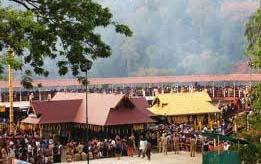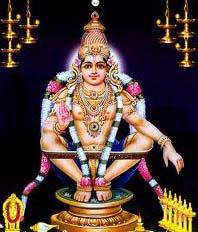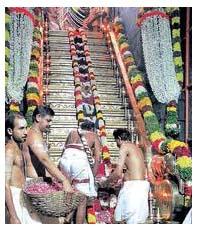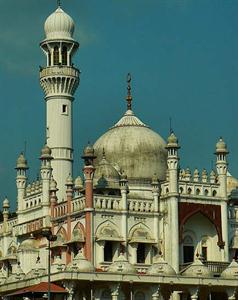What is Sabarimala significance?
Read this article describing about the sabarimala, sabarimala temple, unique aspects of the temple, rituals, the pilgriomage, other shrines nearby usually visited, administration, prasadam, neyyabhishekam, Harivarasanam, message of the Lord and other connected aspects.
Sabarimala – Sabari Mountain
The sacred mountain 'Sabarimala' lies in the rain forest area of the mountain ranges of Western Ghats. Sabarimala is a major pilgrim center in India. It is in the Pathanamthitta District of Kerala. It is part of the vast stretches of evergreen forest of Kerala dotted with rivers and plantations. The forest area covers about half the district. The main river of the area the holy Pampa, enlarged by merger of 5 tributaries, originates in Sabarimala. The top of Sabarimala is 914 meters above sea level. The Sabarimala Temple
 The Sabarimala Mountain is having the distinction of holding the world famous Sabarimala Temple. This temple is dedicated to the Lord Ayyappan the incarnation of Sree Dharma Sastha. Because the temple is on a hill top in the Sabarimala range, the temple of Sree Dharma Sastha - the lord Ayyappan, is known popularly as the Sabarimala Temple. The hill top is 468m (1534 feet) above sea level. It is surrounded by dense forests and mountain and hill ranges. It is one of the oldest and most important temples of Sree Dharma Sastha in India. As mentioned earlier this temple is in the Pathanamthitta District of Kerala. This is one of the very few Hindu temples open to people of all faiths. Though it is a very remote temple and very difficult to reach because of the mountainous terrain and dense forests, this Ayyappan Temple attracts around 50 million pilgrims each year. The temple is the place where Lord Ayyappan was supposed to have meditated without any contact with outside world. There is a belief that this temple is consecrated by the Parasurama Maharishi who retrieved Kerala from Sea by throwing his axe. He is believed to have installed the idol of Ayyappan at the place of the sanctum sanctorum of the present temple. The Ayyappan temple is amidst 18 hills. There is at least one temple on all the hills surrounding the Sabarimala. Some of them are functional while others survive till now on the hills.
The Sabarimala Mountain is having the distinction of holding the world famous Sabarimala Temple. This temple is dedicated to the Lord Ayyappan the incarnation of Sree Dharma Sastha. Because the temple is on a hill top in the Sabarimala range, the temple of Sree Dharma Sastha - the lord Ayyappan, is known popularly as the Sabarimala Temple. The hill top is 468m (1534 feet) above sea level. It is surrounded by dense forests and mountain and hill ranges. It is one of the oldest and most important temples of Sree Dharma Sastha in India. As mentioned earlier this temple is in the Pathanamthitta District of Kerala. This is one of the very few Hindu temples open to people of all faiths. Though it is a very remote temple and very difficult to reach because of the mountainous terrain and dense forests, this Ayyappan Temple attracts around 50 million pilgrims each year. The temple is the place where Lord Ayyappan was supposed to have meditated without any contact with outside world. There is a belief that this temple is consecrated by the Parasurama Maharishi who retrieved Kerala from Sea by throwing his axe. He is believed to have installed the idol of Ayyappan at the place of the sanctum sanctorum of the present temple. The Ayyappan temple is amidst 18 hills. There is at least one temple on all the hills surrounding the Sabarimala. Some of them are functional while others survive till now on the hills.
It is a strong belief that the Ayyappan temple of Sabarimala was built according to the suggestion of the Lord himself to his foster father, the king of Panthalam. There is a shrine for Malikapurathamma on to the left of Lord Ayyappan sannidhanam. The original idol of Ayyappan was a stone (granite) carved one. The present one is a beautiful idol made of panchaloha (a combination of 5 metals) of about one and half feet tall.
The Ayyappan temple stands on a plateau of about 40 feet high on the hilltop. From the plateau one can have a spectacular panoramic view of the surrounding mountains hills and valleys around. Generally the Temples of Kerala are not huge or gigantic like the temples of other neighboring states like Tamilnadu or Karnataka. They are of medium size like the Guruvayur temple or small like the Ayyappan temple. Though there is antiquity about the temple, there was a massive fire in 1950 and the original temple complex was destroyed. The present complex is built after that incident. The complex now consist of a sanctum sanctorum with copper plated roof and 4 golden finials (crowns – thazhika kudam) on top, 2 mandapams, belikalpura (structure to house the altar) and the flag staff (kodimaram). To reach the temple complex devotees have to climb up 18 steps (pathinettu padikal)
Lord Ayyappan was the foster son, though treated as real son, of the Panthalam Raja and the temple was built as suggested by the lord son to the foster father. Hence the temple is considered as under the Raja. The pilgrims are expected to take the permission of the Raja before going to the temple. To make the matter easier there will be a representative of the king with the royal insignia at the base of Neeli mala on the way to Sabarimala. The devotees offer the representative a token sum and receive vibhuthi as token permission. The 3 km ascent up the Neelimala is the steepest segment on the way to the Sabarimala shrine. The Temple is unique in many respects
This temple is a monument of communal and religious harmony, secularism, fraternity, equality and oneness of all human beings. Here all pilgrims are addressed as 'Swami' amongst themselves and by others also. There is no class creed, race or religion and all are equal before the Lord Ayyappan.
It is a convergent center for the Saiva and Vishnava cult followers. It is said that Lord Ayyappan is the son of Hari and Hara (Vishnu and Siva). Hence the Lord is also called as Hariharan.
This is probably the only Hindu temple is open to all irrespective their caste, creed or religion.
On to the East of the Erumeli Temple, very near to it is a mosque dedicated to Vavar (a Sufi Muslim and friend of Lord Ayyappan) known as Vavar nada. This is a symbol of religious harmony. Those who go to Sabarimala for worship are to go these temple and mosque.
Unlike other temples of Kerala, this temple is not open throughout the year. It is open only during the first 5 days of every Malayalam calendar months. Apart from these occasions the major occasions when the temple is open for worship are during the Mandala pooja, Makara vilakku and Chitra (Medam – Mesha) Vishu (Malayalam new year).
There is only one restriction of women between the period of reaching puberty and menopause (that is women between the ages of 10 to 50 are not allowed at Sabarimala temple). The reason attributed by some for this prohibition of entry is because Lord Ayyappan is Brahmachari (bachelor). But this appears to be a wrong one as a Brahmachari if true, need not have any special feeling towards any one including ladies of any age. According to me the reason may be that the health of the ladies who are on menstruation cycles (10 to 50 years of age) may seriously affect as the distance of about 5 km of last leg to the temple is continuous climbing including some distance of steep climbing.The pilgrimage
The main pilgrimage season begins on the 1st of Malayalam calendar month of Vrischika (falls around middle of November of English calendar) and ends in the month of Makaram (around 14th of January). Since last few years pilgrims come not only from South India, but from many other parts of the country and also from some foreign countries. The main events in the temple are the Mandala pooja on the 1st of the month of Vrishcikam, Makara vilakku on the 1st of the month of Makaram around January 14th and Vishu on the Malayalam Vishu (New Year) day which falls in Medam – around April 14th. It is considered as the world's largest annual pilgrimage center. It is reported that about 45 to 50 million people visit the temple every year. Other shrines visited by pilgrims
On the way to the Sabarimala temple, the devotees visit the Sri Dharma Sastha Temple at Erumeli and do the Petta Thullal (a kind of dance). Then proceed to the mosque of Vavar swami which is also at Erumeli. There is a small shrine at the Kanni Moola (South – West corner) of Lord Ganapathi known as the Kanni Moola Ganapathi. Devotees offer their worship here. Some will do special offerings as Ganapathi Homam.
There was a large Homakundam (a sacred pit) to burn the neithenga (The coconut filled with ghee for Lord Ayyappan) after the ghee from the coconut is used for the abhishekam (sacred bath) of Lord Ayyappan. It is the belief that the devotee will get cleansed on the burning of the neithanga. The Homakundam is not there now but there is a place with parapet walls of about 3 – 4 feet high on the right to the temple a little away from the 18 steps to the temple for burning the coconuts. During the pilgrim seasons this place will continuously burn the coconuts thrown by devotees into the enclosure.
There is a small pond in between the Sannidhanam and the shrine of Malikapurathamma. This is known as the Bhasma kulam (pond of sacred ash). After the difficult journey the devotees takes a dip in this pond for the spiritual purification. Since millions of devotees take bath in the pond, the pond is emptied and refilled with fresh water to keep it clean at intervals.
Devotees visit the shrine of Malikapurathamma (Malanadu Bhagavathi) and offer special poojas. Here the devotees roll the coconuts on the ground in front of the shrine, instead of the usual procedure of breaking the coconut as in other temples. The shrine will mostly be closed, but a lamp will be there and pooja will be done at appointed intervals. The offerings here will also include the betel leaves, turmeric powder, silk cloth, saffron (vermillion - kumkumam) and money. Some will offer High sounding crackers and lighted lamps to the goddess.
On to the right side of Malikapurathamma shrine there are shrines of Nagaraja (king of snakes) and Nagayakshi (queen of snakes) where special pujas like sarpa pattu are offered to please the snakes and protect the devotees.
At the base level of the 18 steps (pathinettu padikal) stand the guardians (dwarapalakas) of the Sannidhanam ensuring that the holy steps are not polluted by the devotees by not undergoing the proper vrathas of 41 days of celibacy and abstinence and also ensuring the safety from the dark spirits of forest around. Administration of Sabarimala Temple
The Ayyappan shrine is administered by the Travancore Devaswom Board (TDB). Apart from taking care of the poojas, arrangements for the visits of the pilgrims, arranging to meet the basic needs of the devotees and regular and other maintenance of the temple complex. The TDB has insured the shrine for a value of Rs 30 crores which is equal to $7 million. The Board has arranged for free of cost accident insurance scheme for a limit up to Rs 1 lakh to the devotees numbering about 50 million who may suffer from injuries or death during the stretch from Nilakkal to Sannidhanam (location of temple) a distance of 18 km. The main source of income for the board is from this temple which is about 50 crore rupees during the season from November to January. Prasadams – Offerings
Even a child will tell that the main offering to Lord Ayyappan is the famous Aravana Payasam (a special combination rice, jiggery ghee etc cooked). The rice for the prasadam is given by the temple of Chettikulngara Devi at Mavelikkara. This is the 2nd largest temple under the TDB. Neyyabhishekam to the Lord
Neyyabhishekam means nei abhishekam that is sacred ghee bath to the Lord. This is a very important ritual to the Lord where ghee brought by the devotees in their irumudiketttu also called the pallikettu. The pallikettu is a special kind of bag made of hand woven cotton cloth with two compartments one each at both ends with thick threads to tie the pouches (compartments). This is the bag used by the pilgrims to carry the offerings to the Sabarimala Temple on their heads. It is supposed to be symbolising the merging of Jeevatma (the individual life force) and paramatma (the cosmic life force). The pilgrim of the first time (Kanni Swami or Kanni Ayyappan) usually uses the Irumudi in saffron colour and after that the Irumudi will be of black or navy blue colored cloths. Harivarasanam song for the Lord
Harivarasanam also known as the Harihara suthā ashtakam (8 stanza devotional lyric on Harihara Sutha – son of Hari and Hara – Ayyappan)) is a song set in 'Madhyamavathi' raga (tune) of Indian Karnatic music. This song is played at night at the close of the day's poojas and rituals just before the closing of the temple for the day on all days. This is a lullaby at night known as the urakku paattu. It was composed by Sri Kambangudi Kulathur Srinivasa Iyer. In the beginning Srinivasa Iyer used to sing this song standing in front of the shrine of Ayyappan in the main temple just before closing the temple. It became the lullaby. The composition is of 32 lines of 8 stanzas, 108 words and 352 letters. There are several versions of this song rendered by several prominent vocalists. The temple has selected the recorded one rendered by the Padma Bhushan, Dr and Gana Gandharvan K J Yesudaas. Message of the Lord Ayyappan
At the Sabarimala temple each devotee is given the message of the ultimate knowledge. The message is in the words of 'Tat Tvam Asi' (tat meaning that - god, is you meaning the individual - That Thou Art) in Sanskrit which is the essence of the Sama Veda or the 4 vedas of Hindu philosophy. The meaning of the message is that each one is a god unto himself/herself. It means that each life is part of the cosmic or Universal Soul (Paramatma in Sanskrit). This is the essence of the Advaita (non duality of god and self – oneness) principle of Hindu philosophy propounded by Adi Sankaracharya. Because of this principle each of the pilgrims calls each other Swami.
The poojas are done by a group of thantrees (priests of high knowledge of temple pooja rituals) under the guidance of Mel thanthri (santhi - head preist). Every year the head thantri will be changed and a new one will be selected by a committee of the temple administration. List of daily Sabarimala ritual timings
Sanctum Sanctorum opening at 3.00 a.m.; Usha Pooja 7.30 a.m.; Neyyabhishekam (ablution with ghee brought inside coconuts by pilgrims in their pallikettu) up to12.00 p.m.; Closing of temple after morning pooja at 1.30 p.m.; Opening of temple for evening pujas 3.00 p.m.; Athazha (supper offerings) Pooja10.00 p.m.; Harivarasanam (lullaby before closing the temple for the day) 11.45 p.m.The power to light the way to Illumination
Around 25 to 30 km of the pilgrimage way is dense forest and hence dark even during the day time. But the invisible work of the Kerala State Electricity Board (KEB) is providing enough light in camps, trekking paths, Sannidhanam and surrounding areas. They have installed around 20,000 electric lights of different varieties for this. The KEB is tremendously appreciated and silently and deeply thanked by the pilgrims for their efficient maintenance of the lighting arrangements in the difficult terrain without interruptions.
How to reach Sabarimala
Since the Sabarimala temple is amidst a group of 18 hills covered by dense rain forests, there are not many ways to reach there. But there are 3 routes established for Sabarimala pilgrimage.
Erumeli route – This was the route used by Lord Ayyappan for killing the demonic Mahishi who was a nuisance and terror to people of the Panthalam kingdom – the kingdom of Ayyappan's foster parents. This route is the most difficult one of the three. The distance is 61 km to cover on foot through the forests and hill track.
Vandiperiyar route– This route begins at the 94.4th km on the Kottayam – Kumili Road. From here the distance to the Sannidhanam (temple complex of Lord Ayyappan) is about 13 km.
Chalakkayam route
This is the easiest of all the routes. Chalakkayam is near the Pampa River. From here to the Sannidhanam is only 8 km.
Air ports The nearest International air port is Thiruvananthapuram air port which is 184 km away from the temple. From Nedumbasseri (Kochi) International air port the distance is 214 km. Nearest Railway stations are Kottayam and Chengannur.ACCOMMODATION AND FACILITIES
Adjoining the nada pandal (sheltered pathway) a multistoried pilgrim complex is built and also there are some other pilgrim sheds on the Northern side in and around Pandy Thavalam. After this area a series of public latrines are provided. During the pilgrim seasons a Government Hospital and Ayurvedic Hospital functions at the South Eastern side near to nada pandal. There is a dispensary near the Donors complex run by the N S S near to the Malikappuram shrine. All inquiries about accommodation are to be made at the accommodation office on the North side of lower thirumuttam (sacred court yard) near to the donor building and maintenance complex.
Public call office and a telephone exchange with STD/ISD call facilities functions here. Police security is stationed at all important areas on the routes.
Free food supplies are provided by voluntary organizations throughout the route. Food stalls also provide food on payment.



 Job oriented
Job oriented